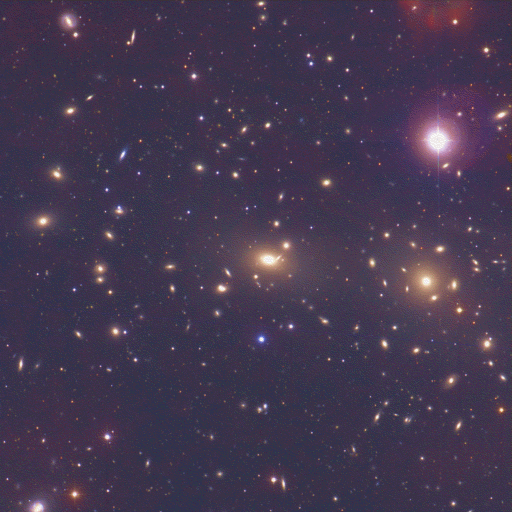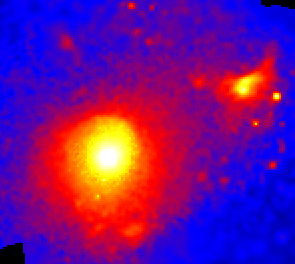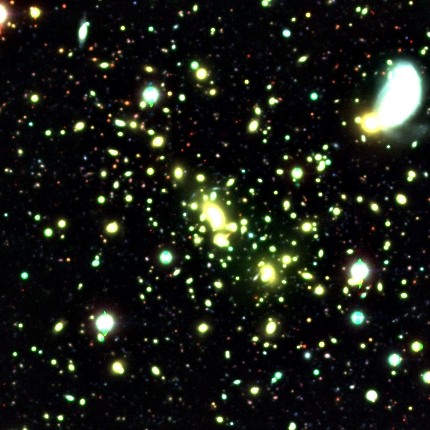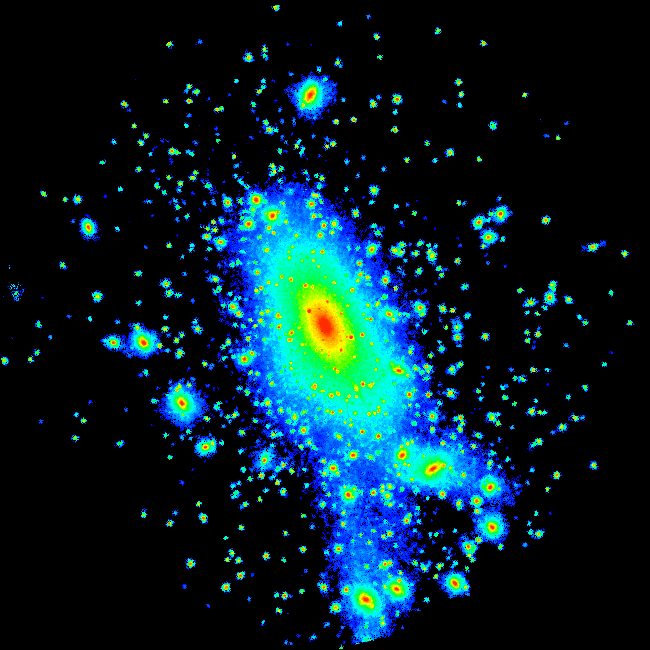The Colour-Magnitude Relation for Elliptical Galaxies
Background Information: Clusters of Galaxies
 Rich cluster of galaxies have central masses
of 10,000 × the mass of the Milky Way, and as such are both the
most massive collapsed systems and also some of
the intrinsically rarest systems in the Universe. Most galaxies
inhabit the field, crudely defined as the lower-density
regions outside clusters and voids. Although these field galaxies will
themselves lie in structures, typically in groups of a few galaxies.
The Local Group comprises our Galaxy and Andromeda (M31), as well as a
number of smaller galaxies, in a single gravitationally-bound
structure. Nevertheless, the Local Group resides on the edge of a
moderate-sized cluster in Virgo, and the group is in the process of
falling into this cluster. Within the next few billion years the
surroundings of our Galaxy will look very different. The most massive
nearby cluster is the Coma cluster (left) the central regions of which
are dominated by two super-massive elliptical galaxies. The extreme
conditions found in such rich clusters including very high densities of
galaxies, as well as large amounts of very hot gas which emit at X-ray
wavelengths, making clusters some of the most luminous X-ray sources in the sky (see
below). In addition to galaxies and hot gas, galaxy clusters contain
populations of stars which are not bound to individual galaxies, these
have been stripped out of galaxies in the cluster by tidal
interactions. As we will see below the vastly different conditions
found in the centres of clusters, compared to the lower density field,
are associated with differences in the properties of the galaxies in
the two environments and in particular with differences in their
morphologies.
Rich cluster of galaxies have central masses
of 10,000 × the mass of the Milky Way, and as such are both the
most massive collapsed systems and also some of
the intrinsically rarest systems in the Universe. Most galaxies
inhabit the field, crudely defined as the lower-density
regions outside clusters and voids. Although these field galaxies will
themselves lie in structures, typically in groups of a few galaxies.
The Local Group comprises our Galaxy and Andromeda (M31), as well as a
number of smaller galaxies, in a single gravitationally-bound
structure. Nevertheless, the Local Group resides on the edge of a
moderate-sized cluster in Virgo, and the group is in the process of
falling into this cluster. Within the next few billion years the
surroundings of our Galaxy will look very different. The most massive
nearby cluster is the Coma cluster (left) the central regions of which
are dominated by two super-massive elliptical galaxies. The extreme
conditions found in such rich clusters including very high densities of
galaxies, as well as large amounts of very hot gas which emit at X-ray
wavelengths, making clusters some of the most luminous X-ray sources in the sky (see
below). In addition to galaxies and hot gas, galaxy clusters contain
populations of stars which are not bound to individual galaxies, these
have been stripped out of galaxies in the cluster by tidal
interactions. As we will see below the vastly different conditions
found in the centres of clusters, compared to the lower density field,
are associated with differences in the properties of the galaxies in
the two environments and in particular with differences in their
morphologies.
 The image here shows a view of
the core of the Virgo cluster in the X-ray waveband and illustrates the
structure of the hot, gravitationally-bound gas in the cluster's
potential well. This potential well is sufficiently deep that the gas
between the galaxies within the cluster is compressed and heated to
high enough temperature that emits radiation at X-ray wavelengths.
Images of this X-ray radiation illustrate the very extended potential
well of the cluster, which contains two major peaks, associated with
sub-groups of galaxies within the cluster. Nevertheless, the X-ray
image still appears much smoother than the distribution of the
individual galaxies. Moreover, the temperature and the distribution of
the X-ray gas can be used to estimate the mass of the cluster (assuming
that the hot X-ray gas behaves as an ideal gas) and in
all cases this has been found to significantly exceed the mass
contained within the galaxies. These observations are one of the
strongest pieces of evidence for dark matter on large scales in the
Universe. Observing at X-ray wavelengths requires the use satellites
to get above the absorption from the Earth's atmosphere, which is
opaque in the X-ray band.
The image here shows a view of
the core of the Virgo cluster in the X-ray waveband and illustrates the
structure of the hot, gravitationally-bound gas in the cluster's
potential well. This potential well is sufficiently deep that the gas
between the galaxies within the cluster is compressed and heated to
high enough temperature that emits radiation at X-ray wavelengths.
Images of this X-ray radiation illustrate the very extended potential
well of the cluster, which contains two major peaks, associated with
sub-groups of galaxies within the cluster. Nevertheless, the X-ray
image still appears much smoother than the distribution of the
individual galaxies. Moreover, the temperature and the distribution of
the X-ray gas can be used to estimate the mass of the cluster (assuming
that the hot X-ray gas behaves as an ideal gas) and in
all cases this has been found to significantly exceed the mass
contained within the galaxies. These observations are one of the
strongest pieces of evidence for dark matter on large scales in the
Universe. Observing at X-ray wavelengths requires the use satellites
to get above the absorption from the Earth's atmosphere, which is
opaque in the X-ray band.
 The image to the left illustrates
a view of the central regions, a 1 Mpc across, of a distant rich
cluster. This is a true colour image, constructed from individual
exposures through blue (B), visual (V) and
infrared (I) filters, and the large numbers of yellow galaxies are the luminous cluster galaxies (the
large interacting spiral in the upper-right hand corner is foreground of
the cluster). The strong central concentration of galaxies in the cluster
can be readily seen, and the cluster centre is further highlighted by the
massive dominant galaxy lying at the bottom of the cluster's potential
well. This massive elliptical galaxy has accreted an extended envelope
of stars stripped from other galaxies passing through the cluster core.
The central parts of the cluster are sufficiently massive to bend the
space-time, this deflects the paths of photons passing through the
core of the cluster in a phenomenum called `gravitational-lensing'.
The deflection means that the images of background galaxies seen
through the cluster appear to be distorted into concentric arcs around
the cluster. A number of gravitationally-lensed arcs are visible around
the central galaxy in this cluster, these are star-forming galaxies at
high redshift and are therefore blue, appearing conspicious against the
red, central cluster galaxy. Arcs are also visible around a secondary
sub-clump within the cluster below the central galaxy.
The image to the left illustrates
a view of the central regions, a 1 Mpc across, of a distant rich
cluster. This is a true colour image, constructed from individual
exposures through blue (B), visual (V) and
infrared (I) filters, and the large numbers of yellow galaxies are the luminous cluster galaxies (the
large interacting spiral in the upper-right hand corner is foreground of
the cluster). The strong central concentration of galaxies in the cluster
can be readily seen, and the cluster centre is further highlighted by the
massive dominant galaxy lying at the bottom of the cluster's potential
well. This massive elliptical galaxy has accreted an extended envelope
of stars stripped from other galaxies passing through the cluster core.
The central parts of the cluster are sufficiently massive to bend the
space-time, this deflects the paths of photons passing through the
core of the cluster in a phenomenum called `gravitational-lensing'.
The deflection means that the images of background galaxies seen
through the cluster appear to be distorted into concentric arcs around
the cluster. A number of gravitationally-lensed arcs are visible around
the central galaxy in this cluster, these are star-forming galaxies at
high redshift and are therefore blue, appearing conspicious against the
red, central cluster galaxy. Arcs are also visible around a secondary
sub-clump within the cluster below the central galaxy.
 Clusters of galaxies are of particular interest for testing models of
galaxy evolution in high density regions. The possibility that galaxy
properties, such as luminosity or morphology, can be altered by
interactions within rich clusters has led to considerable theoretical
work on predicting the expected effects of these interactions on model
galaxies. The figure here shows
such a simulation, where the motions and interactions of galaxies have
been followed through the formation and collapse of a rich cluster. The
density of the mass in the cluster is colour coded with the densest
regions having red and yellow colours, and less dense regions blue and black. The
simulation, although it simply follows Newton's laws, relies on highly
sophisticated code running on the most powerful, parrallel
supercomputers available. Direct comparisons of the observations and
simulations of rich clusters of galaxies allow astronomers to test and
refine their models of the growth of structure in the Universe.
Clusters of galaxies are of particular interest for testing models of
galaxy evolution in high density regions. The possibility that galaxy
properties, such as luminosity or morphology, can be altered by
interactions within rich clusters has led to considerable theoretical
work on predicting the expected effects of these interactions on model
galaxies. The figure here shows
such a simulation, where the motions and interactions of galaxies have
been followed through the formation and collapse of a rich cluster. The
density of the mass in the cluster is colour coded with the densest
regions having red and yellow colours, and less dense regions blue and black. The
simulation, although it simply follows Newton's laws, relies on highly
sophisticated code running on the most powerful, parrallel
supercomputers available. Direct comparisons of the observations and
simulations of rich clusters of galaxies allow astronomers to test and
refine their models of the growth of structure in the Universe.
Back to Main page
 Rich cluster of galaxies have central masses
of 10,000 × the mass of the Milky Way, and as such are both the
most massive collapsed systems and also some of
the intrinsically rarest systems in the Universe. Most galaxies
inhabit the field, crudely defined as the lower-density
regions outside clusters and voids. Although these field galaxies will
themselves lie in structures, typically in groups of a few galaxies.
The Local Group comprises our Galaxy and Andromeda (M31), as well as a
number of smaller galaxies, in a single gravitationally-bound
structure. Nevertheless, the Local Group resides on the edge of a
moderate-sized cluster in Virgo, and the group is in the process of
falling into this cluster. Within the next few billion years the
surroundings of our Galaxy will look very different. The most massive
nearby cluster is the Coma cluster (left) the central regions of which
are dominated by two super-massive elliptical galaxies. The extreme
conditions found in such rich clusters including very high densities of
galaxies, as well as large amounts of very hot gas which emit at X-ray
wavelengths, making clusters some of the most luminous X-ray sources in the sky (see
below). In addition to galaxies and hot gas, galaxy clusters contain
populations of stars which are not bound to individual galaxies, these
have been stripped out of galaxies in the cluster by tidal
interactions. As we will see below the vastly different conditions
found in the centres of clusters, compared to the lower density field,
are associated with differences in the properties of the galaxies in
the two environments and in particular with differences in their
morphologies.
Rich cluster of galaxies have central masses
of 10,000 × the mass of the Milky Way, and as such are both the
most massive collapsed systems and also some of
the intrinsically rarest systems in the Universe. Most galaxies
inhabit the field, crudely defined as the lower-density
regions outside clusters and voids. Although these field galaxies will
themselves lie in structures, typically in groups of a few galaxies.
The Local Group comprises our Galaxy and Andromeda (M31), as well as a
number of smaller galaxies, in a single gravitationally-bound
structure. Nevertheless, the Local Group resides on the edge of a
moderate-sized cluster in Virgo, and the group is in the process of
falling into this cluster. Within the next few billion years the
surroundings of our Galaxy will look very different. The most massive
nearby cluster is the Coma cluster (left) the central regions of which
are dominated by two super-massive elliptical galaxies. The extreme
conditions found in such rich clusters including very high densities of
galaxies, as well as large amounts of very hot gas which emit at X-ray
wavelengths, making clusters some of the most luminous X-ray sources in the sky (see
below). In addition to galaxies and hot gas, galaxy clusters contain
populations of stars which are not bound to individual galaxies, these
have been stripped out of galaxies in the cluster by tidal
interactions. As we will see below the vastly different conditions
found in the centres of clusters, compared to the lower density field,
are associated with differences in the properties of the galaxies in
the two environments and in particular with differences in their
morphologies.


